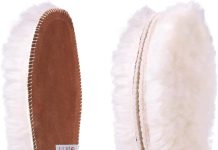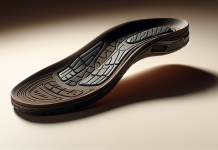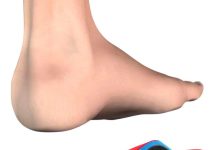If you’ve ever experienced discomfort or pain while wearing your favorite pair of women’s shoes, you might be wondering if there are insoles made specifically to provide added comfort and support for women’s feet. Well, good news! There are indeed insoles designed especially for women’s shoes. These specially tailored insoles aim to cater to the unique shape and structure of women’s feet, providing them with the much-needed cushioning and arch support for all-day comfort. In this article, we will explore the benefits of using insoles made specifically for women’s shoes and how they can enhance your overall footwear experience. So get ready to step into a world of comfortable, supportive shoes made just for you.
Understanding Insoles
Insoles, also known as shoe inserts or footbeds, are inserts that are placed inside shoes to provide additional support, cushioning, and comfort. They are designed to improve the fit of shoes, alleviate foot pain and discomfort, and address specific foot issues. Insoles can be made from various materials such as foam, gel, or cork, and come in different shapes and sizes to cater to different shoe types.
How do insoles work?
Insoles work by providing additional support and cushioning to the feet, redistributing pressure, and stabilizing the foot inside the shoe. They help absorb shock and impact while walking or running, and can help correct biomechanical imbalances that may lead to foot, ankle, or knee pain. Insoles can also help improve posture, reduce fatigue, and enhance overall comfort during prolonged standing or physical activity.
Benefits of using insoles
Using insoles can offer a range of benefits for individuals, regardless of gender. Some of the key benefits of using insoles include:
-
Enhanced comfort: Insoles provide an extra layer of cushioning and support, making shoes more comfortable to wear for extended periods.
-
Improved foot stability: Insoles help stabilize the foot inside the shoe, reducing the risk of foot, ankle, or knee injuries.
-
Pain relief: Insoles can help alleviate various foot conditions such as plantar fasciitis, shin splints, and Achilles tendonitis by providing targeted support and pressure relief.
-
Corrective support: Certain types of insoles, such as orthotic insoles, can help correct biomechanical issues, such as overpronation or supination, improving overall foot alignment.
-
Odor control and hygiene: Some insoles are designed with antimicrobial properties to prevent the growth of odor-causing bacteria and keep feet fresh and hygienic.
Different types of insoles
There are several different types of insoles available in the market, each catering to specific needs and preferences. Some common types of insoles include:
-
Arch support insoles: These insoles are designed to support the natural arch of the foot, providing stability and preventing the arch from collapsing. They are particularly beneficial for individuals with flat or high arches.
-
Cushioning insoles: These insoles are made from soft, shock-absorbing materials and are primarily focused on providing comfort by reducing the impact on the feet. They are ideal for individuals who spend long hours on their feet or engage in high-impact activities.
-
Orthotic insoles: Orthotic insoles are specifically designed to address biomechanical issues and provide corrective support. They are often recommended by healthcare professionals for individuals with conditions such as plantar fasciitis, bunions, or foot and ankle instability.
-
Heel support insoles: As the name suggests, these insoles focus on providing extra cushioning and stability to the heel area. They are beneficial for individuals suffering from heel pain or conditions like plantar fasciitis and Achilles tendonitis.
-
Sport-specific insoles: These insoles are designed to cater to the needs of athletes and individuals involved in specific sports activities. They offer targeted support and cushioning to minimize the risk of sports-related injuries.
The Importance of Insoles for Women’s Shoes
While insoles can be beneficial for individuals of all genders, women’s shoes often require special insoles due to the specific discomforts and foot issues experienced by women. Women generally have different foot anatomy and tend to wear shoes with narrower toe boxes and higher heels, which can cause a range of foot problems.
Why women’s shoes require special insoles
Women’s shoes often prioritize fashion and style over comfort and functionality. High heels, for example, can put excessive pressure on the balls of the feet and lead to conditions like metatarsalgia or Morton’s neuroma. Additionally, women are more prone to developing foot issues like bunions and hammertoes due to the prolonged wearing of narrow and pointy-toed shoes. Special insoles designed for women’s shoes can help alleviate these issues and provide the necessary support and cushioning for better foot health.
Common discomforts experienced by women
Women commonly experience a variety of foot discomforts associated with their shoe choices. Some of the common discomforts include:
-
Forefoot pain: Tight-fitting shoes and high heels can cause pain in the balls of the feet, as they increase pressure on this area.
-
Heel pain: Women who wear high heels or shoes with poor cushioning often suffer from heel pain, including conditions like plantar fasciitis or Achilles tendonitis.
-
Arch pain: The lack of proper arch support in many women’s shoes can lead to arch pain and discomfort.
-
Toe pain: Narrow and pointy-toed shoes can squeeze the toes together, leading to pain, corns, and bunions.
-
Fatigue and discomfort: Prolonged standing or walking in ill-fitting shoes can result in overall foot fatigue and discomfort.
How insoles can address these discomforts
Special insoles for women’s shoes are designed to specifically address the common discomforts experienced by women. These insoles offer targeted support and cushioning in the areas where women’s shoes often lack proper design.
Arch support insoles can provide stability to the arches, reducing arch pain and helping to alleviate conditions like plantar fasciitis. Cushioning insoles can absorb shock and reduce pressure on the forefoot and heels, providing relief from pain. Heel support insoles help cushion the heels and reduce the strain on the plantar fascia and Achilles tendon. Additionally, orthotic insoles can correct biomechanical imbalances and provide overall foot alignment, addressing issues like overpronation or supination.
By using insoles specifically designed for women’s shoes, women can experience greater comfort, reduced pain, and improved foot health.
Characteristics of Women’s Insoles
When selecting insoles for women’s shoes, it is important to consider certain characteristics that are specific to women’s foot anatomy and shoe preferences. These characteristics include:
Size and shape
Women’s insoles should be available in a range of sizes to cater to different foot lengths and widths. Additionally, they should be designed to fit the unique shape of women’s feet, offering proper support and alignment.
Support and cushioning
Women’s insoles should provide adequate support and cushioning to address the specific discomforts experienced by women. The level of support and cushioning can vary depending on individual foot needs and preferences.
Heel and arch support
Given that women often wear shoes with higher heels and tighter toe boxes, women’s insoles should offer additional heel and arch support to provide stability and reduce the risk of foot problems.
Material and breathability
Women’s insoles should be made from breathable materials to prevent excessive sweating and odor. Additionally, the material should be durable and easy to clean for long-lasting use.
Types of Insoles for Women’s Shoes
There are various types of insoles available specifically designed for women’s shoes. These include:
Orthotic insoles
Orthotic insoles are designed to provide customized support and correction for specific foot issues. They are often recommended for individuals with conditions like plantar fasciitis, flat feet, or high arches.
Cushioning insoles
Cushioning insoles are made from soft, shock-absorbing materials to provide additional comfort and cushioning. They are ideal for individuals who stand or walk for long periods or engage in high-impact activities.
High-heel insoles
High-heel insoles are specifically designed to provide extra cushioning and support for the balls of the feet and the heels, reducing the pressure and impact caused by wearing high heels.
Sport-specific insoles
Sport-specific insoles are designed to cater to the needs of athletes and individuals engaging in specific sports activities. These insoles offer targeted support and cushioning to minimize the risk of sports-related injuries and enhance performance.
Choosing the Right Insoles for Women’s Shoes
When choosing the right insoles for women’s shoes, it is important to consider the specific foot issues and needs. Some factors to consider include:
Identifying specific foot issues and needs
Take into account any existing foot conditions or discomforts and choose insoles that target those specific issues. Consulting with a healthcare professional or podiatrist can help determine the most suitable type of insole for individual needs.
Consideration of shoe type and activity level
Consider the type of shoes that will be worn with the insoles and the level of activity they will be used for. Different shoe types and activities may require different levels of support and cushioning.
Consulting with a podiatrist or shoe specialist
If unsure about the most appropriate type of insole, it can be beneficial to seek advice from a podiatrist or shoe specialist who can provide expert guidance based on individual foot structure, needs, and lifestyle.
Popular Brands for Women’s Insoles
Several brands specialize in producing insoles specifically tailored for women’s shoes. Some popular brands include:
Dr. Scholl’s
Dr. Scholl’s is a well-known brand that offers a wide range of insoles for women’s shoes. Their insoles are designed to provide comfort, support, and pain relief.
Superfeet
Superfeet is another reputable brand that focuses on providing durable and supportive insoles. They offer a variety of insoles designed for women’s specific needs, including arch support and cushioning options.
Sof Sole
Sof Sole is known for their high-quality and affordable insoles. They offer a range of insoles with different levels of support and cushioning, catering to various foot needs.
Powerstep
Powerstep is a brand that specializes in orthotic insoles. Their insoles are designed to provide maximum support and stability for individuals with specific foot issues.
Taking Care of Women’s Insoles
To ensure the longevity and effectiveness of women’s insoles, it is important to take proper care of them. Some care and maintenance tips include:
Cleaning and maintenance tips
Follow the manufacturer’s guidelines for cleaning and maintenance. Insoles can typically be wiped clean with a damp cloth and mild soap. Avoid submerging them in water or machine washing to prevent damage.
Replacing worn-out insoles
Insoles eventually wear out over time and lose their effectiveness. It is important to regularly assess the condition of insoles and replace them when signs of wear, such as flattened cushioning or decreased support, become apparent.
Customer Reviews and Feedback
Customer reviews and feedback can offer valuable insights into the effectiveness and reliability of women’s insoles. Positive experiences shared by customers may indicate the satisfaction and benefits provided by specific brands or types of insoles. However, it is important to remember that individual experiences may vary, and what works for one person may not work for another.
Conclusion
Insoles designed specifically for women’s shoes offer specific benefits in terms of comfort, support, and alleviating common foot discomforts. By choosing the right type of insole and properly maintaining them, women can enhance their overall foot health and enjoy greater comfort while wearing their favorite shoes. Proper selection of insoles should take into consideration individual foot needs, the type of shoes to be worn, and the level of activity involved. When in doubt, consulting with a healthcare professional or shoe specialist can help ensure the optimal choice of insoles for women’s shoes.









































